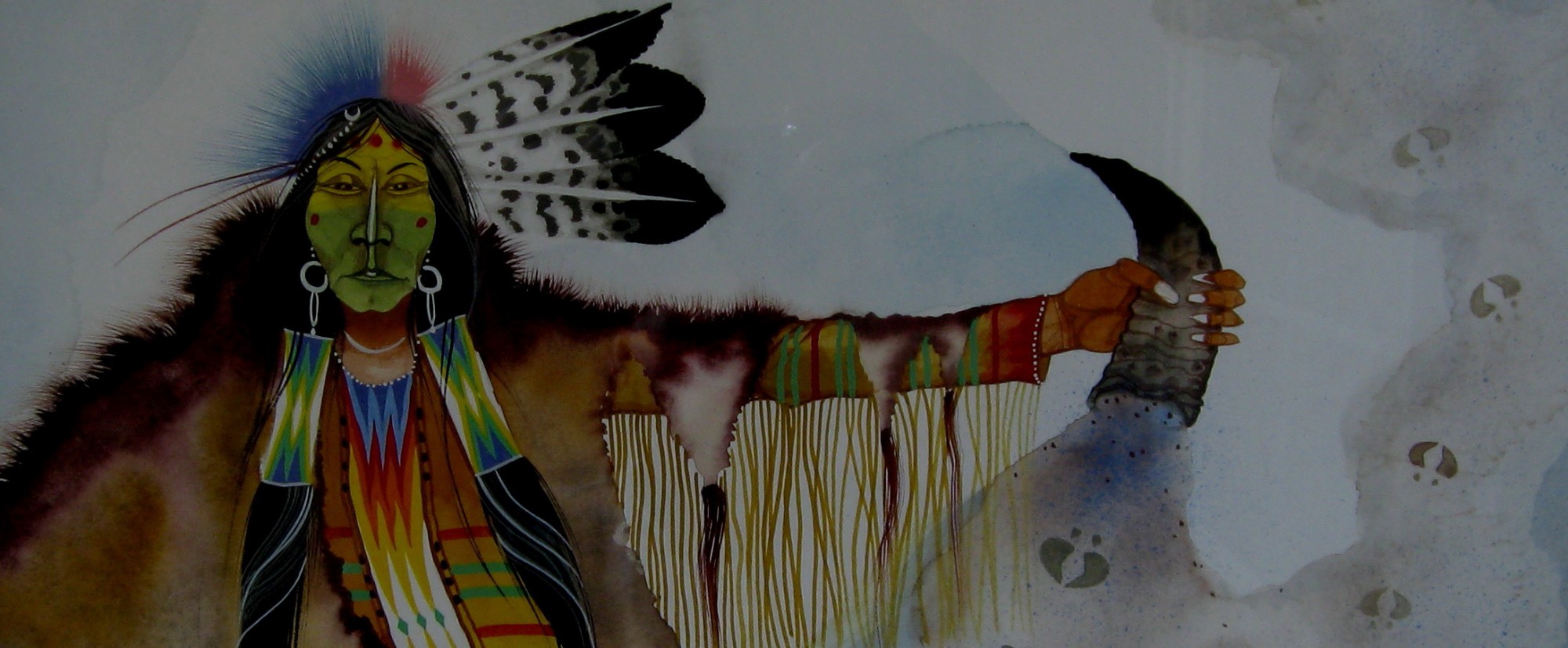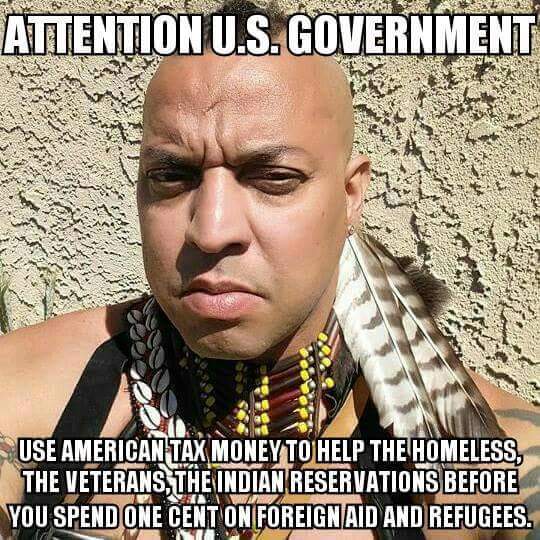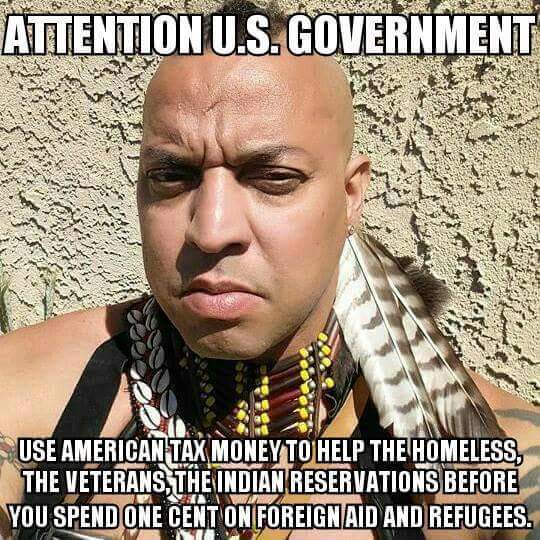There has been much debate regarding the allowing of Syrian refugees into the United States. Personally, I don’t buy into the scare tactics that some in the mainstream media are trying to push on the masses. What I do have an issue with is the fact that for some reason the government can find money to house, feed, and assist these people from outside the country but cannot seem to find a solution for the homeless and hungry here, not to mention the Indigenous living in less than 3rd World conditions in some reservations.
In this post I am taking the time to research this subject thoroughly in order to provide information and education on these issues so that we may have a better grasp of what is going on. Hopefully, we can find a way to take care of our own as much as we are taking care of others…
First, I am going to share some statistics with you about living conditions on some of the “Indian Reservations” here in the United States, then we will go over the rest of the homeless and hungry.
- About 40% of our country’s 4.9 million Native Americans live on reservations (2008, Office of Minority Health). Living conditions on the reservations have been cited as “comparable to Third World.” (May 5, 2004, Gallup Independent).
- The overall percentage of American Indians living below the federal poverty line is 28.2%” (2008, American Indians Census Facts). The disparity for American Indians on the reservations is even greater, reaching 38% to 63% in our service area (2006, National Center for Education Statistics, and other sources).
- American Indians are 20% more likely to have heart disease than other Americans and to die from it at a younger age (American Heart Association, per Indian Health Service, 2001). American Indians are 600% more likely to die from heart disease than other Americans, 226% more likely to die from diabetes, and 600% more likely to die from tuberculosis (2006, Indian Health Disparities). Disparities related to rates of cancer and cancer treatment are also higher than for any other Americans (2005, Native People for Cancer Control).
- Despite the Indian Housing Authority’s (IHA’s) recent efforts, the need for adequate housing on reservations remains acute. The legislature deplored the fact that there are 90,000 homeless or under-housed Indian families, that 30% of Indian housing is overcrowded, and less than 50% of it is connected to a public sewer” (March 10, 2004, Indian Country Today)
- About 40% of on-reservation housing is considered inadequate (2003, Native American Indian Housing Council). The waiting list for tribal housing is long and overcrowding is inevitable. Most families will not turn away family members or anyone who needs a place to stay. It is not uncommon for 3 to 4 generations to live in a two-bedroom home.
Pine Ridge Reservation
Pine Ridge is among the US’s largest Indian reservations – much smaller than the vast plains of the midwest that the Sioux once roamed but still bigger than England’s largest county – and also among its poorest. No one is sure how many people live on its 2.2 million acres, but the tribe estimates about 45,000.
Conditions on the reservation are tough. More than 80% unemployment. A desperate shortage of housing – on average, more than 15 people live in each home and others get by in cars and trailers. More than one-third of homes lacking running water or electricity. An infant mortality rate at three times the US national average. And a dependency on alcohol and a diet so poor that half the population over the age of 40 is diabetic.
The Oglala Sioux’s per capita income is around $7,000 (£4,400) a year, less than one-sixth of the national average and on a par with Bulgaria. The residents of Wounded Knee, scene of the notorious 1890 massacre of Sioux women and children and of the 1973 standoff with the FBI, are typically living on less than half of that. Young people have almost no hope of work unless they sign up to fight in Afghanistan. The few with jobs are almost all employed by the tribal authorities or the federal government. It is not uncommon to hear people quietly speak of the guilt they feel for having a job. Those who don’t survive on pitifully small welfare checks. It all adds up to a life expectancy on Pine Ridge of about only 50 years.
Native Americans teenagers are more likely to kill themselves than any other minority group. Some statistics show the rate at three times the national average. But those figures shield the fact that self-harm is most likely to occur on poorer reservations, such as Pine Ridge and neighboring Rosebud; here rates are far higher.
I could go on and on about the deplorable conditions for Native Americans living on most reservations here in the U.S. but the links at the bottom should give you an indication of how severe the problem is.
Next, let’s look at the non-native homeless in the United States, beginning with veterans.
The U.S. Department of Veterans Affairs (VA) states that the nation’s homeless veterans are predominantly male, with roughly 9% being female. The majority are single; live in urban areas; and suffer from mental illness, alcohol and/or substance abuse, or co-occurring disorders. About 11% of the adult homeless population are veterans.
Roughly 45% of all homeless veterans are African American or Hispanic, despite only accounting for 10.4% and 3.4% of the U.S. veteran population, respectively.
Homeless veterans are younger on average than the total veteran population. Approximately 9% are between the ages of 18 and 30, and 41% are between the ages of 31 and 50. Conversely, only 5% of all veterans are between the ages of 18 and 30, and less than 23% are between 31 and 50.
America’s homeless veterans have served in World War II, the Korean War, Cold War, Vietnam War, Grenada, Panama, Lebanon, Persian Gulf War, Afghanistan and Iraq (OEF/OIF), and the military’s anti-drug cultivation efforts in South America. Nearly half of homeless veterans served during the Vietnam era. Two-thirds served our country for at least three years, and one-third were stationed in a war zone.
About 1.4 million other veterans, meanwhile, are considered at risk of homelessness due to poverty, lack of support networks, and dismal living conditions in overcrowded or substandard housing.
Veterans & Homelessness
- Number of veterans in the U.S. as of 2014: approximately 22.5 million2
- Increasing numbers of returning military personnel: according to the Mass. Dept. of Veterans’ Services, approximately 31,000 service members have returned to the Commonwealth since Sept. 11, 2001.
- Between 529,000 and 840,000 veterans are homeless at some time during the year.2
- On any given night, more than 300,000 veterans are living on the streets or in shelters in the U.S.
- Approx. 33% of homeless males in the U.S. are veterans.2
- Veterans are twice as likely as other Americans to become chronically homeless.2
- Veterans represent 11% of the adult civilian population, but 26% of the homeless population, according to the Homeless Research Institute (2007).
- Veterans are more at risk of becoming homeless than non-veterans
- The number of homeless Vietnam-era veterans, male and female, is greater than the number of soldiers who died during the war.1
- Primary causes of homelessness among veterans are:
- Lack of income due to limited education and lack of transferable skills from military to civilian life (especially true of younger veterans returning from Iraq and Afghanistan)
- Combat-related physical health issues and disabilities
- Combat-related mental health issues and disabilities
- Substance abuse problems that interfere with job retention
- Weak social networks due to problems adjusting to civilian life
- Lack of services
Now, let’s look at homeless children in the U.S.
The number of homeless children in the U.S. has surged in recent years to an all-time high, amounting to one child in every 30, according to a comprehensive state-by-state report that blames the nation’s high poverty rate, the lack of affordable housing and the impacts of pervasive domestic violence.
Titled “America’s Youngest Outcasts,” the report being by the National Center on Family Homelessness from 2014, calculates that nearly 2.5 million American children were homeless at some point in 2013. The number is based on the Department of Education’s latest count of 1.3 million homeless children in public schools, supplemented by estimates of homeless pre-school children not counted by the DOE.
The problem is particularly severe in California, which has one-eighth of the U.S. population but accounts for more than one-fifth of the homeless children with a tally of nearly 527,000.
Child homelessness increased by 8 percent nationally from 2012 to 2013, according to the report, which warned of potentially devastating effects on children’s educational, emotional and social development, as well as on their parents’ health, employment prospects and parenting abilities.
The report included a composite index ranking the states on the extent of child homelessness, efforts to combat it, and the overall level of child well-being. States with the best scores were Minnesota, Nebraska and Massachusetts. At the bottom were Alabama, Mississippi and California.
Please read the references linked below to learn more on statistics of homeless children in America.
General Homelessness Statistics
POPULATIONS AT RISK OF HOMELESSNESS
Many poor people are at risk of homelessness. Ultimately, this is because it is hard for them to afford housing. Unemployment, housing cost burden, and living doubled up are indications of this struggle to afford housing. Longitudinal trends and changes from 2012 to 2013 indicate populations at risk of homelessness may not be experiencing the benefits of the economic recovery.
- The number of unemployed people fell 8.4 percent and the unemployment rate continued its multi-year decline, falling to 7.4 percent. Nearly all states saw decreases in the number of people unemployed, with only 6 states seeing modest increases in the number of unemployed people.
- Despite improvements in employment, the number of people in poverty (4.8 million) and the poverty rate (15.8 percent) remained relatively steady. 26 states saw an increase in the number of people in poverty; 25 saw a decrease.
- The number of people in poor households living doubled up with family and friends grew to 7.7 million people, an increase of 3.7 percent from 2012 to 2013, with 39 states seeing increases. Since 2007, the number of people living doubled up has increased 67 percent.
- The number of poor renter households experiencing severe housing cost burden, those households in poverty paying more than 50 percent of their income toward housing, total 6.4 million in 2013, decreasing by 2.8 percent nationally from 2013 with 37 states seeing a decrease. Since 2007, the number of poor households with severe housing cost burden has increased 25 percent.
| Demographic make-up of the homeless population | Percent |
| Single Men | 44 % |
| Single Women | 13 % |
| Families with Children | 36 % |
| Unaccompanied Minors | 7 % |
| Racial breakdown of homeless population | Percent |
| African-American | 50 % |
| White | 35 % |
| Hispanic | 12 % |
| Native American | 2 % |
| Asian | 1 % |
Now that we have taken a look at the plight of Native Americans, homeless vets, children, and the rest of the homeless population let’s look at the plan for welcoming and housing Syrian refugees here in the United States.
It is not clear how much the screening process for Syrians costs, but the US government spent $1.1 billion last year resettling 70,000 people from around the world, or almost $16,000 per head.
The government plans to welcome at least 10,000 Syrian refugees over the next year. This means that the cost for them alone will be in excess of of $160,000,000.
I have included links below to references that discuss the Syrian refugee relocation in detail. Again, my issue is with the fact that as shown above we aren’t doing enough to take care of our own. If we are going to lay out the welcome carpet for Syrian refugees then we owe it to our homeless and impoverished citizens to do more to help them.
Storm
References
Native American Homeless
http://www.nrcprograms.org/site/PageServer?pagename=airc_livingconditions
http://www.americanindianchildren.org/living_conditions.html
http://www.thejournal.ie/photos-life-indian-reservation-810416-Mar2013/
http://www.perc.org/articles/how-government-keeps-indians-poverty
Homeless Veterans
http://nchv.org/index.php/news/media/background_and_statistics/
http://www.veteransinc.org/about-us/statistics/
http://www.endhomelessness.org/library/entry/fact-sheet-veteran-homelessness
http://www.nationalhomeless.org/factsheets/veterans.html
Homeless Children
http://www.homelesschildrenamerica.org/
http://www.familyhomelessness.org/children.php?p=ts
http://www.huffingtonpost.com/2014/11/17/child-homelessless-us_n_6169994.html
http://www.nationalhomeless.org/factsheets/How_Many.html
Overall Homeless Statistics
http://www.endhomelessness.org/library/entry/the-state-of-homelessness-in-america-2015
http://www.endhomelessness.org/pages/snapshot_of_homelessness
http://www.statisticbrain.com/homelessness-stats/
Syrian Refugee Facts
http://www.state.gov/r/pa/prs/ps/2015/11/250005.htm
http://www.businessinsider.com/afp-how-the-us-plans-to-welcome-10000-syrian-refugees-2015-9


